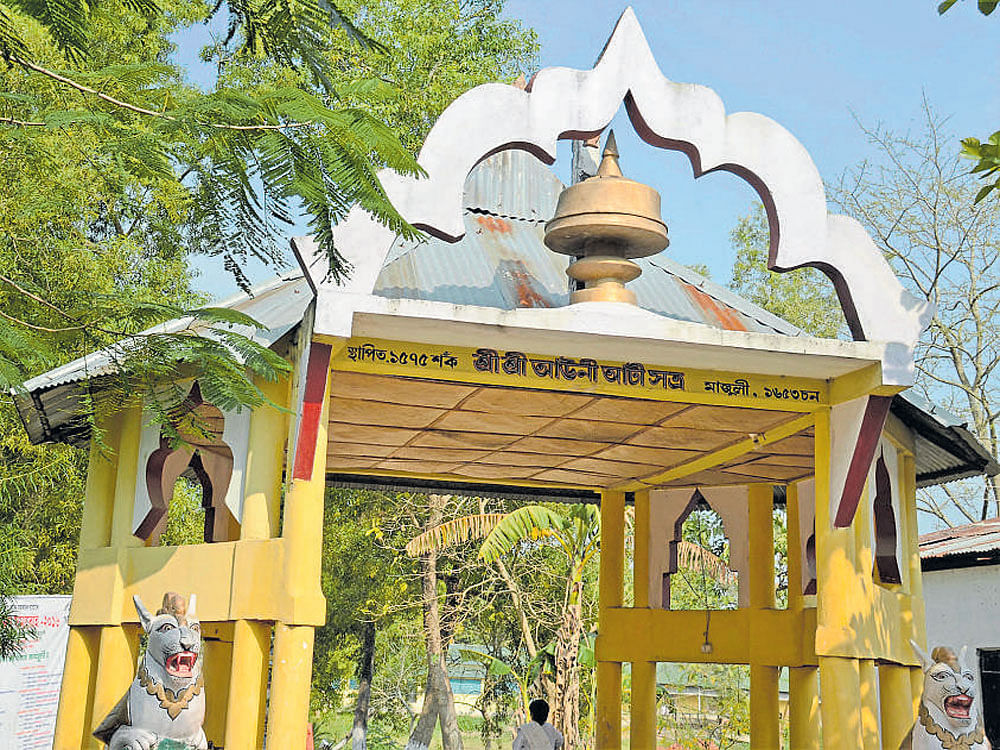I should have guessed as I got down from the car at Nimati Ghat. We had driven some 14 kilometres from Jorhat, the trading town in Upper Assam, partly on a busy highway and thereafter on a winding road through fields, shrubs and languid villages. Then suddenly at a bend, a sweeping openness appeared dramatically on the northern flank. The Brahmaputra river.
“You better get down from the car, Sir,” said Diganta, the driver. And I was thankful for his suggestion. He deftly drove the car down the slushy, scary-steep incline and stopped at the edge of a makeshift jetty on the river. A puny-looking man put two wooden planks, almost as narrow as the tyres, between the jetty and a country boat. To make matters worse, the boat was bobbing, and with it the planks. Mr Puny started directing Diganta, and I exclaimed, “Can you make it?” Diganta returned a paan-stained smile at me as he revved up the car on first gear and the front tyres rolled up on the slender planks. My heart stopped.
When our boat finally left the jetty, there were two more cars on it along with a dozen of two-wheelers, cycles and plenty of people. And why not? For there are just about five or six ferries a day to Majuli, and those remain the only material connection of the largest riverine island of the world to the outer world. That too, if Brahmaputra is in an agreeable mood.
Across the river
The romance of crossing the Brahmaputra on a country boat, with a whole jingbang of a crowded traffic junction in it, demands a separate feature. But the hour-long sail, and the river is wide enough to blur out the other bank from the field of vision, if anything, was a trailer of the flick waiting on the other side — the island of Majuli. And my curiosity was to experience, first hand, the inimitable cultural heritage of its satras.
Satras are religio-cultural institutions established in the Vaishnava tradition by the 16th century social reformer Srimanta Sankardeva and his disciple Madhabdeva. Sankardeva’s genius lay in his presenting Vaishnavism as a reforming and redeeming medium through a comprehensive cultural revolution by uplifting music, craft and performing arts. And he institutionalised his vision, which is now termed Neo-Vaishnavism, by creating the satras.
Of the original 64 satras, 31 are still functioning in Majuli as living testimony of the 450-year-old cultural heritage. Interestingly, each satra has its unique artistic attribute in music, literature, dance, drama, and handicraft.
I met Koshakanta Dev Goswami, the much-admired satradhikar — the head — of Natun (New) Samaguri Satra. Goswami is a Sangeet Natak Academy awardee as a master mask maker, and naturally, is the toast of entire Majuli. In broken Hindi mixed with English, often veering into Assamese, which was promptly interpreted by his college-going grandson, he showed and explained to me how masks are made. A complex and intricate process which demands a very high level of skill and diligence.
“Traditionally, these masks are not stand-alone entities,” said Goswami, “but integral to the expressions of the bhaona they are associated with.” Bhaona is a form of drama originated by Srimanta Sankardeva, to spread Neo-Vaishnavism through entertainment and folk art. The stories are mostly of episodes from the Ramayana and the life of Krishna. Most of the masks, therefore, relate to the characters played out in bhaonas like Kalia Daman, Ram Vijay, Narakasura Vadh.
Next day, I went to Auniati Satra on the other side of Majuli Island. There I came to know that some satras are grihasthi satras, where people marry and the tradition of the art form is carried forward through family lines. While other satras are udasin — which literally means carefree, but figuratively of celibate monastic order. Unlike the mask-making Natun Samaguri, which is grihasthi, Auniati is udasin.
Through songs & dance
Each satra has its own Namghar, the place to gather for prayers accompanied by kirtan, and occasionally, dance. When I walked into Auniati Satra, rehearsal of some drama was going on at the Namghar. Vishnupada, one of the bhaktas, or inmates of the satra, explained that their satra would be performing the bhaona of Bhakta Prahlad two days from then. “One of our bhaktas has scripted the bhaona. And we have very accomplished singers and players of khol and kartal.” Khol is a mridangam kind of percussion with a small diameter on one end giving a sharper sound, and is a popular instrument with Vaishnava kirtans. Kartal is the pair of metallic cymbals which, in a kirtan, go almost as the alter ego of the khol.
I witnessed the full radiance of khol and kartal the following evening at Uttar Kamalabari Satra. Gayan-Bayan, which is the satra tradition of dancing while singing and playing on percussions, had just started in the Namghar. Bhaktas in white attire, some with khol and others with kartal swayed and swooned as they danced to the kirtan they sang in praise of Lord Vishnu. Though their National Award-winning khol player, Paramananda Borgayan, was not present, the bhaktas, presumably his disciples, slowly built up the tempo towards a crescendo. It was hypnotic, that complete immersion of the self in the act.
As my boat left the jetty, I looked back at receding Majuli. Forlorn and restful, as if nothing ever happens there. It was only when the shoreline hazed out that I realised how Majuli conducts itself in such low key. How the songs and dramas of its satras play out to the subliminal; and remain and grow inside a person. And that I too was carrying a sliver of that drama across the Brahmaputra, to the outer world.
